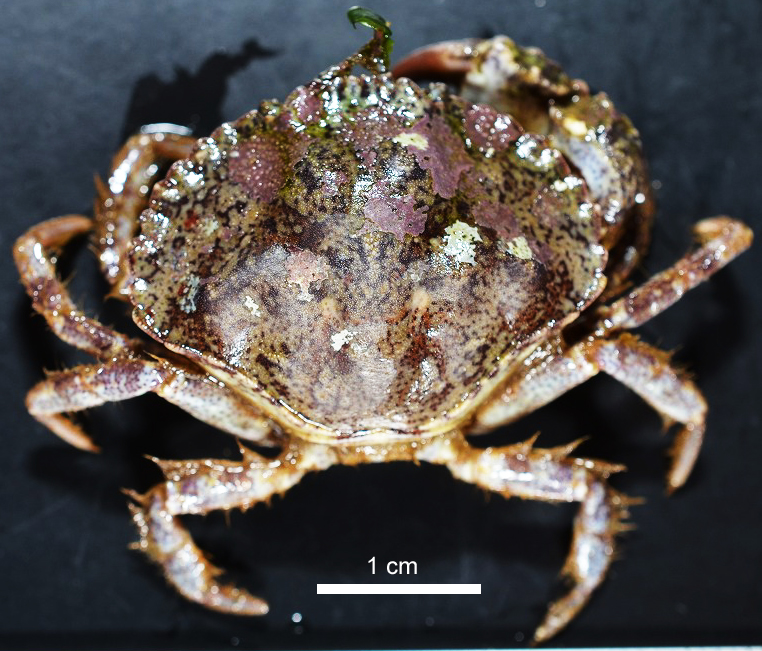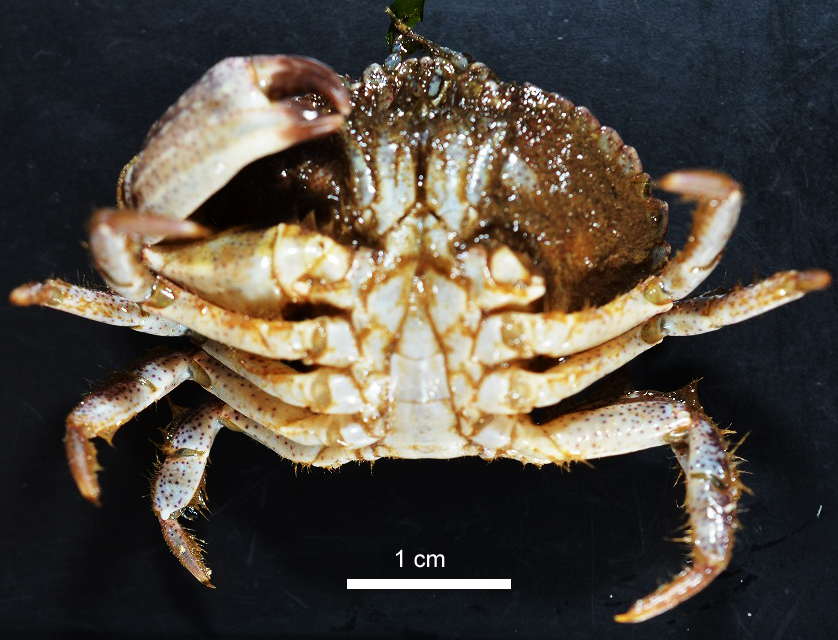A crab was collected in the intertidal zone of Oshoro Bay, Hokkaido, Japan, about 43°12′N, 140°51′E, on 27 May 2013 by Natsu Sugama and Ami Kawahata, photographed and identified by Hiroshi Kajihara as Cancer amphioetus by a reference to Wada (1995), but the generic affiliation of the species herein follows that of Schweitzer and Feldmann (2000); the specimen was then fixed in 99% EtOH. Total DNA was extracted from the walking leg using the silica method (Boom et al. 1990) with some modifications. Extracted DNA was dissolved in 30 µl of deionized water and has been preserved at –20°C. Remaining morphological voucher specimen has been deposited at the Hokkaido University Museum under the catalogue number ICHU2110776 (contact: Dr. Hiroshi Kajihara, kazi@mail.sci.hokudai.ac.jp).
An about 700-bp fragment of the mitochondrial cytochrome c oxidase subunit I gene (COI) was amplified by polymerase chain reaction (PCR) using LCO1490 (5′-GGTCAACAAATCATAAAGATATTGG-3′) and HCO2198 (5′-TAAACTTCAGGGTGACCAAAAAATCA-3′) (Folmer et al. 1994). A hot start PCR was performed by a 2720 Thermal Cycler (Applied Biosystems), in a 20-µl reaction volume containing 1 µl of template total DNA (approximately 10–100 ng) and 19 µl of premix made with 632-µl deionized water, 80-µl Ex Taq Buffer (TaKara Bio), 64-µl dNTP (each 25 mM), 8-µl each primer (each 10 µM), and 0.1-µl TaKara Ex Taq (5 U/µl, TaKara Bio). Thermal cycling condition comprised an initial denaturation at 95°C for 30 sec; 30 cycles of denaturation at 95°C for 30 sec, annealing at 45°C for 30 sec, and elongation at 72°C for 45 sec; and a final elongation at 72°C for 7 min.
The PCR product was purified with the silica method (Boom et al. 1990). Both strands were sequenced with a BigDye® Terminator v3.1 Cycle Sequencing Kit (Applied Biosystems) following the manufacturer's protocol, using the same primer set as the initial PCR amplification. Sequencing was performed with ABI Prism 3730 DNA Analyzer (Applied Biosystems). Chromatogram and sequence data were processed with MEGA v.5 software (Tamura et al. 2011).
Results
Phylum Arthropoda
Subphylum Crustacea
Class Malacostraca
Subclass Eumalacostraca
Order Decapoda
Suborder Pleocyemata
Family Cancridae Latreille, 1802
Genus Glebocarcinus Nations, 1975
Glebocarcinus amphioetus (Ruthbun, 1898)
[Japanese name: koichou-gani]
(Figs 1, 2)
After eliminating the primer sites, a total of 658 bp of COI sequence was determined from our specimen (see Appendix). A Blast search (Altschul et al. 1997), as implemented in the NCBI website (http://www.ncbi.nlm.nih.gov/), resulted in 99% identity (with 100% query coverage and 0.0 E value) of the present sequence witw JX502942, a 658-bp strech of COI sequence from Glebocarcinus amphioetus from South Korea (Kim et al. 2012, unpublished data).

Fig. 1. Glebocarcinus amphioetus (Ruthbun, 1898) (ICHU2110776), from Oshoro Bay, Hokkaido, Japan, dorsal view, taken in life.

Fig. 2. Glebocarcinus amphioetus (Ruthbun, 1898) (ICHU2110776), ventral view; the left cheliped had been detached when collected.
References
Boom, R., Sol, C. J. A., Salimans, M. M. M., Jansen, C. L., Wertheim-van Dillen, P. M. E., and Van der Noordaa, J. 1990. Rapid and simple method for purification of nucleic acids. Journal of Clinical Microbiology 28: 495–503.
Folmer, O., Black, M., Hoeh, W., Lutz, R., and Vrijenhoek, R. 1994. DNA primers for amplification of mitochondrial cytochrome c oxidase subunit I from diverse metazoan invertebrates. Molecular Marine Biology and Biotechnology 3: 294–299.
Schweitzer, C. E. and Feldmann, R. M. 2000. Re-evaluation of the Cancridae Latreille, 1802 (Decapoda: Brachyura) including three new genera and three new species. Contributions to Zoology 69(4): 223–250.
Tamura, K., Peterson, D., Peterson, N., Stecher, G., Nei, M., and Kumar, S. MEGA5: molecular evolutionary genetics analysis using maximum likelihood, evolutionary distance, and maximum parsimony methods. Molecular Phylogenetics and Evolution 24: 1596–1599.
Wada, K. 1995. Brachyura. Pp. 379–418. In: Nishimura, S. (Ed.) Guide to Seashore Animals of Japan with Color Pictures and Keys, Vol. II. Hoikusha, Osaka.
Appendix
COI sequence (658 bp) from ICHU2110776 identidied as Glebocarcinus amphioetus collected in Oshoro Bay, Hokkaido, northern Japan.
TACATTATATTTCATTTTTGGAGCTTGAGCTGGAATGGTTGGAACCTCTTTGAGGTTAATTATCCGCGCTGAACTTGGACAACCGGGGACTCTTATTAGAAATGATCAAATTTATAATGTTGTTGTCACTGCCCACGCTTTTGTAATAATTTTTTTTATAGTTATACCAATTATAATTGGGGGATTTGGAAATTGACTAGTTCCTTTAATATTAGGGGCACCTGACATAGCCTTTCCCCGAATAAATAACATAAGATTTTGACTTTTACCTCCCTCTCTAACACTACTTCTTATAAGAGGTATAGTTGAAAGAGGAGTCGGAACGGGATGGACCGTTTACCCTCCTTTAGCAGGAGCTATTGCCCACGCTGGAGCCTCAGTAGATATAGGAATTTTTTCCTTACATTTAGCAGGAGTTTCTTCTATTCTGGGAGCTGTAAACTTCATAACAACTGTAATTAATATACGATCTTTTGGTATAACTTTAGACCAAATGCCCCTTTTCGTTTGAGCTGTATTTATTACTGCTATCTTACTACTCTTATCTCTTCCTGTTCTAGCAGGTGCAATTACTATATTACTAACTGACCGAAATTTAAACACTTCTTTCTTTGATCCGGCAGGAGGGGGAGACCCAGTCCTCTATCAGCATCTCTTT